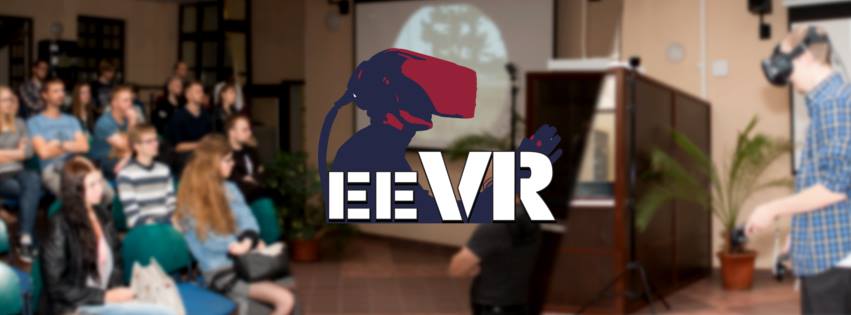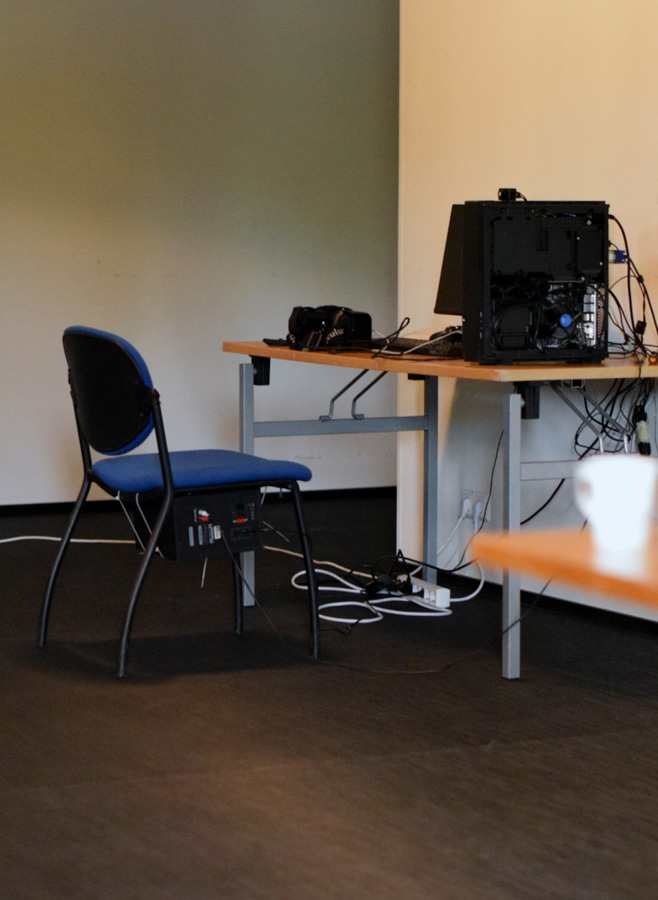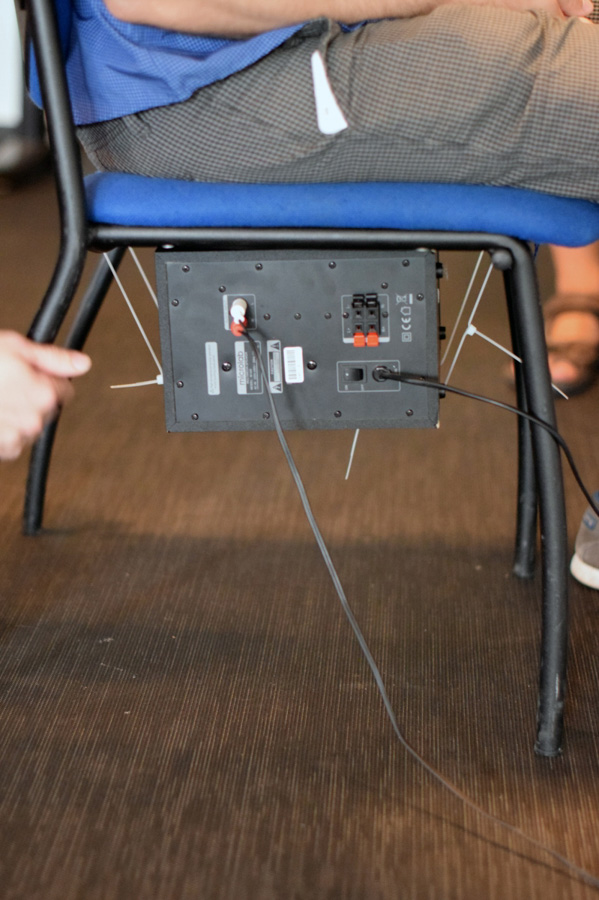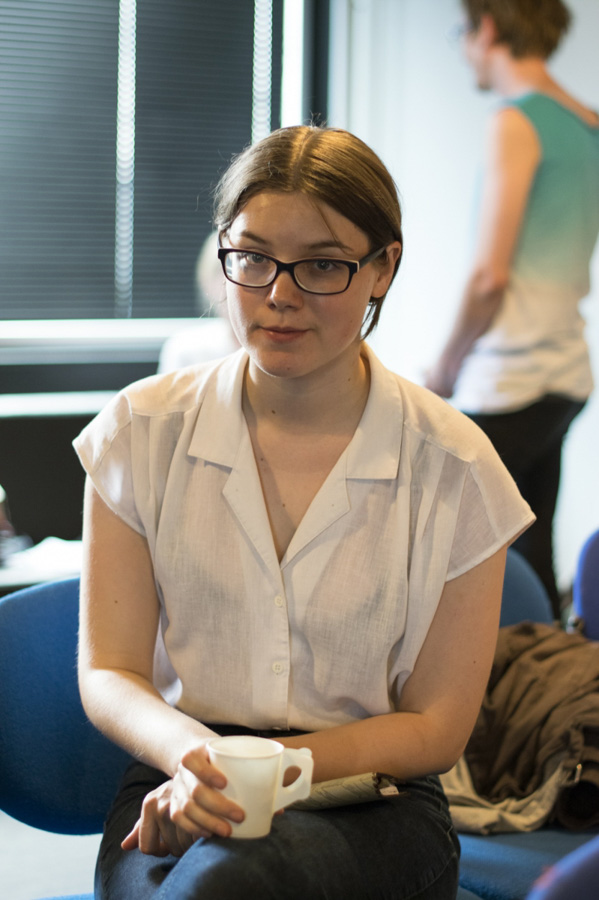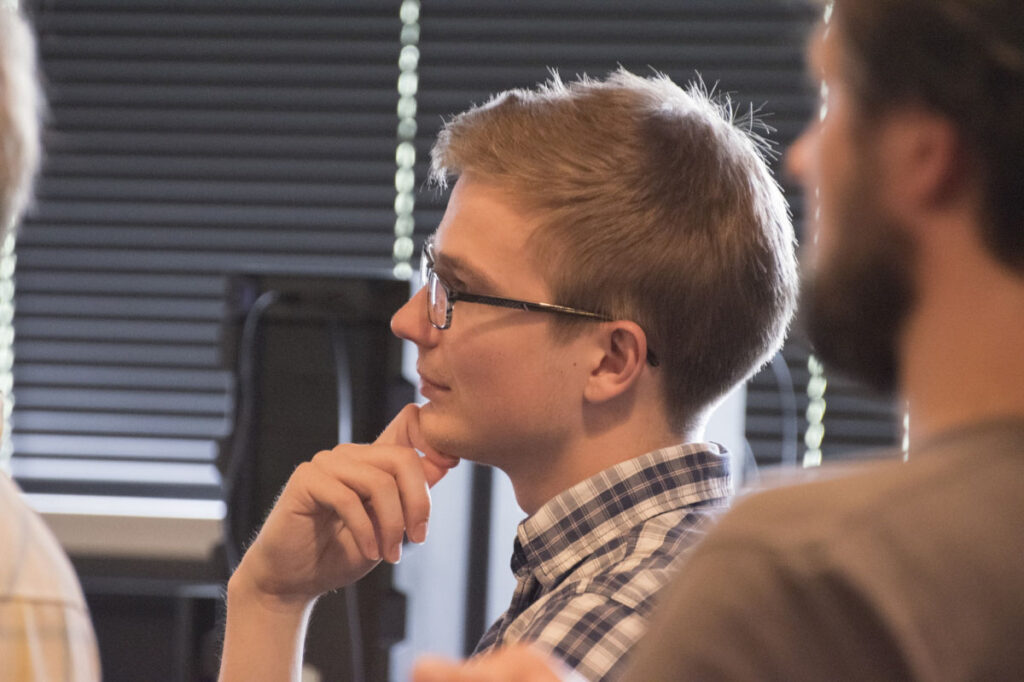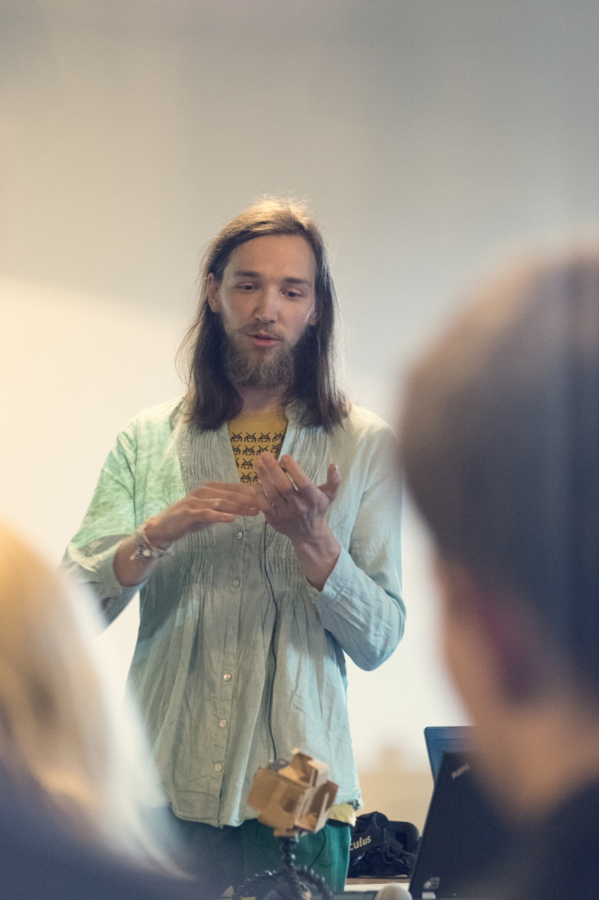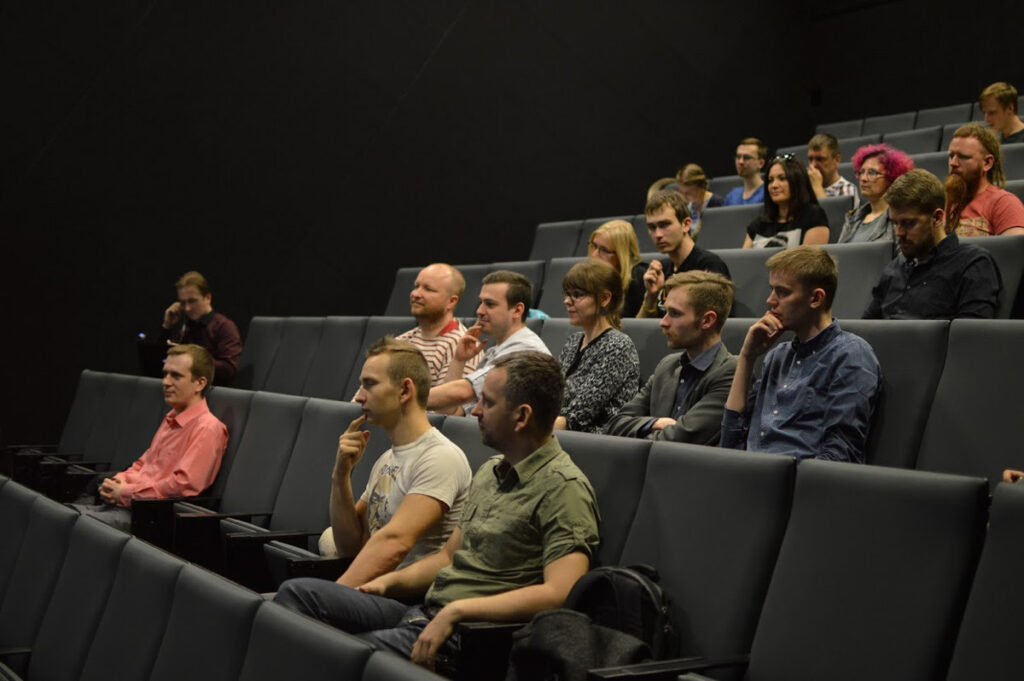

May 7th 2016 saw another round of EEVR, this time carrying the number 9. Although one of our main speakers happened to get ill just before the meetup, we still managed to easily fill many hours of interesting talks and demos. We were once again hosted by Digix at the Baltic film- and media school. This time we even got to be in a movie theater!
First up was an EEVR regular Filipp Keks, talking about his recent visit to the GDC. In terms of VR the GDC hall was packed with all sorts of new headsets, young crazy developers and VR-specific talks. One of the most interesting demos Filipp tried was a tracking solution that could identify both the players and any other objects that had appropriate markers. In the demo there was a basketball you could reliably bounce around without losing tracking.
Ofcourse, once you threw the ball too high, the virtual version would stop mid-air and before you knew it, you got smacked in the head with reality. The solution was cool, and very-very expensive. There was also some technology for untethered VR that actually worked, so we might see VR cabels dissapearing sooner than we might think.
Next we had a presentation by Aleksander Väljamäe, a local academic and researcher who has been heavily involved in VR related science since the beginning of the 2000s. The presentation gave a really brief introduction to his wealth of work already done in the VR space. This included auditory illusions, the sense of self-motion, out of body experiences etc. Currently Aleksander is setting up a new lab in Tallinn University to investigate brain-computer interactions through media. For anyone dealing with VR audio, this talk will surely give some interesting new insight.
Check slides.
The demo sessions were fun as always. A few people got to try out a public speaking anxiety simulator by Madis Vasser, some had the chance to try out Battle 360 curesy of Maksim Vladimirovich, many tried the new Oculus Home demos brought by PsychoBus and EVERYONE stood in line for the HTC Vive show by Mario Saarik!
More pictures of the event can be found here.
Until next time (in july?) at EEVR #10 in Tartu!

At last, the meetup has reached the point of no return – we can’t be bothered with roman numerals any longer! So, EEVR 8 took place on february 13th, once again in Tartu, Estonia. This time we were welcomed by Tartu Art School 3D Designers. Of course, many other professions were also present, be it developers, scientists or enthusiasts. The event was a first in many ways: it was the first time one of the two main organizers was absent, the first time we had international speakers and the first time no-one brought their own PCs on site! What exactly went down is detailed below.
First we had a video bridge with Kyra Hendrix and Diana Skopina from MSI, who took us through their line of “VR ready” products. We heard about the latest graphics cards, gaming technologies and also had the change to ask the MSI reps some questions. One big suprise for many was the fact that MSI “VR Ready” laptops were the go-to hardware for many VR demos in this years CES and that said laptops can power the giants like HTC Vive for hours, without being plugged to the wall! MSI also sent a nice swag-box for the event participants, so nobody was left empty-handed.
Next up was Haver Järveoja from Luna 3D (and Wolfprint and many other interesting projects), talking and showing 3D scanning via photogrammetry. Basically they have constructed a self-operated scanner that people can use in a public place to scan their portrait. In a few hours, the mesh can be sent directly to the customer or it can be “planted” on a pre-made character, depending on the context. For example, in the sea plane hangar you could become a virtual pilot. Many developers in the audience showed interested in high-resolution scans and Luna itself is also looking for talented modellers to construct more characters for “faceplanting”.
Last one in the spotlight was again Madis Vasser, a true EEVR veteran. This time he spoke about a little fieldtrip abroad, visiting one “leading company in VR knowledge transfer” in the UK. He came back with mixed feelings, but these are best left discussed in the video.
The bottom line – VR headsets are the future, no other technology even comes close.
The demo sessions were fun as always. As the art school provided PCs, all that people had to do was to bring their headsets. And so we had a nice row of HMDs lined up, from a DK1 to many DK2s, and also some mobile systems. Content wise people had the chance to try out EVE:Valkyrie alpha, I Expect You To Die, Keep Talking and Nobody Explodes and also some local stuff, such as the University of Tartu rollercoaster by PsychoBus.
Pics from the whole event can be found here.
Until we meet again in april!

It was yet another warm winter day on december 19th, when dozens of estonian VR developers and enthusiasts came together to talk about the many burning questions. What do people mean by “virtual reality”? Is there still a place for a CAVE VR system in todays world dominated by head-mounted displays? And what do we need to foster VR development in Estonia? Luckily we got answers to many of those questions thanks to our awesome speakers and demo stations.
First up was Egert Ronald Parts from TTK University of Applied Sciences, introducing the new CAVE VR system they have on the premises in Tallinn. First he gave an overall introduction of the CAVE approach – that is immersing the viewer by projecting stereoscopic images around different flat surfaces in the room via projectors. In TTK’s case there are a total of five screens – three walls, the ceiling and the floor.
The setup is used to validate new engineering and architectural approaches in virtual space. Egert argued that the ability to share the virtual space with other spectators also wearing stereoscopic glasses is a major advantage over head-mounted displays. There was a brief debate about social VR and it’s ability to replace every possible CAVE solution soon. But as for now, CAVEs definitely win in terms of the users own full-body presence. Those who have a stronger urge to try one of these systems out should contact Egert via egert@tktk.ee.
The second speaker was once again Madis Vasser, this time sharing his tips and tricks on the topic of how to talk about VR to the general public through VR demos. As many know, talking about VR without showing it can be a lost cause, as people really do not grasp the idea behind say presence without having the experience themself. His recipe for a good 30-minute introduction included the following: VR Lab rats (to demonstrate the fundamental difference between playing the same game on the screen versus in VR), Deep Space VR (to show that the content has not size limitations), Back to Dinosaur Island (no time restrictions either, so yay for timetravel), Senza Peso (to highlight the abstract side of VR), Henry trailer (to show the power of interactivity) and Blocked In (to emphasize that VR can also be a standing experience and that the future of computer interaction will be so much more natural than today). He finished with a call to action to create more VR-compatible content, as the tools for this are freely available and require zero-to-minimal programming skills.
Lastly we had our host, Martin Aadamsoo from the digital crative media incubator Digix. Together with the audience we discussed the needs and opportunities of the estonian VR community and how to foster growth and progress in this sector. We got many answers to the question “what do developers need?”. First and foremost was hardware – different headsets and peripherals, as no single developer has the means to gather all of the new shiny toys (soon to be) out there. Yet, developing something for said hardware might be worthwhile, so a place to try these gadgets out before commiting oneself is badly needed. It was decided that a more formal questionnaire will be devised and sent to the dev community to work out the exact needs. But if this VR incubator dream comes true, the waiting line behind the door will probably be quite long!
In the demo area we had some interesting exhibits, as usual. People got to out try the legendary AntVR (sadly not having its best day), the GearVR innovator edition, some simpler mobile headsets/spectacles and also the mandatory Oculus. Content wise there were the usual Elite:Dangerous and I Expect You To Die (thanks Mario!), other demos from the web (thanks PsychoBus!) and also many homegrown experiments. One was an impressive mobile turret shooter by Maksim Vladimirovich called “Battle 360“, the other a quick Gear VR test scene by Karel Airapetjan.
Madis also showed his work with porting different Unreal demos to VR, namely Landscape Mountains hang-glider and the Matinee fight scene. He also organized a quick mini-game with his “spinning tunnel” demo (to be released) where people had to try as hard as they can to stand on one foot for as long as possible. Much harder than it sounds when your eyes tell you that the room is tilting! Much general netwoking and buzz also took place and many decided that perhaps our next local meetup before the actual phycial one in february will be held in VR! Many thanks to Digix for the awesome place and snacks, and to everyone coming out!
More pictures here.
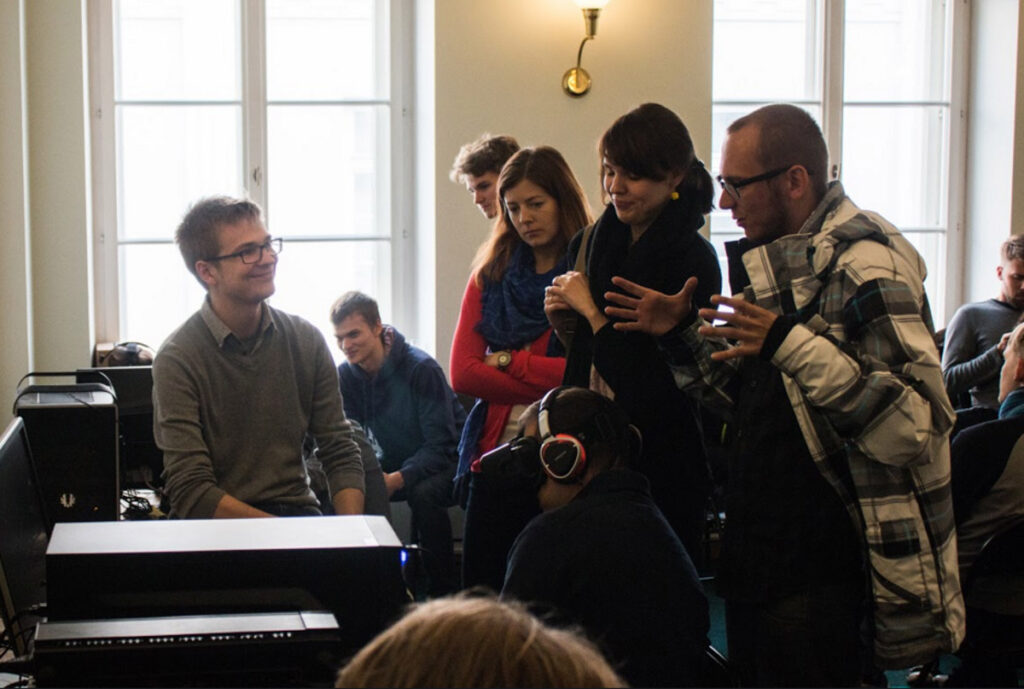
EEVR VI marked the first successful year of Estonian VR meetups! The idea started around october 2014 and has steadily grown ever since, connecting people every second month. And to celebrate, people from all over the country gathered in Tartu at the newly opened Garage48 HUB to hear some great talks and experience many new home-grown VR demos, as usual.
First we had Mario and Madis on stage, sharing their year of EEVR as the organizers. Some statistics were spilled, memories refreshed and future plans discussed. Even though the community has exploded from 2 members to 212 over just a year, there has emerged a core group of about 30 people who actively develop VR software or hardware. We can only hope that EEVR has had some influence in increacing that number.
Next we heard from Kälver Kilvits and his work at Street-U, a company dealing with mapping city streets. He showed us the ropes of getting a VR app running with three.js and Oculus libraries. It’s a surprisingly simple undertaking, if you know the basics. The result was a live web-based experience to navigate through the virtual streets of Tartu. The potential for mapping cities with lazers to create massive point clouds was also discussed in lenght.
Link to slides.
Lastly we got to be a part of Karel Airapetjan’s trip to Oculus Connect 2. His talk was mostly centered on different demo experiences that he had the chance to try out. Now we know that the fur textures in Henry are really nice and the Bullet Train metal surfaces look gorgeus 🙂 We also heard many “first hand” experiences with Oculus Touch and a comparison between Touch and Vive controllers. In summary – both are good, depending on what you want to achieve.
The demo round was especially rich this time around. Those interested could for example pop their head inside the long anticipated OSVR HDK 1.2 and we also took a look under the hood, as the HDK is easily hackable to pieces. Another cool hardware gadget was a rally seat by Keijo, who let people try out Dirt Rally and Assetto Corsa with maximum immersion. Turning to the game scene, our local prodigy Ats Kurvet was showing off his Mythos of the world axis, and also a new demo for the Epic Megajam, Teleported. Madis demonstrated the glory of Oculus 0.7 runtime with Showdown, Henry trailer and some of his own random experiments. One of those was an asymmetric Leap Motion demo, where one player was controlling the “hand of god”, while the other player inside the rift was climbing up said hand. Great for a bunch of mini-games, stay tuned for more 🙂 Hendrik Proosa showed his quick demo about rendered lightfields in Unity, which left many scraching their head in hopes of understanding the tech behind the cool experience.
Also, check out the pics! (Thanks Karl)

EEVR V saw two awesome game industry events EEVR and IGDA Mixer join forces to bring a fun evening dedicated to games, virtual reality and making new connections. Although the meetup was held in Tallinn, at the Saku Suurhall convention center on august 8th, the event was a chilled out meeting of 27 like-minded enthusiasts.
First we heard from Ott Jeeser and his borderline-VR experimentation “Puppet Master” that allows you to control a game character that is an actual human walking around in the room. The Master has the controls, while the Puppet sees nothing but a smartphone display that occasionally lights up with instructions. Ott and his team have cooked up some great mini-games that people can try out, like sending your Puppet for a walk, playing soccer against other Puppets or engage in a cardboard box fight. This experiment is great for inducing the feeling of telepathy, when you see your thought being carried out in complete silence. Try it for free here – http://puppetmaster.ee/.
Ott also revealed his 360-degree videos and drawings that everyone fell in love with instantly. The videos were shot with a custom cardboard rig and with only one camera. This worked great with rather still scenes. But shooting every angle separately produced some interesting effects in moving shots – depending on where you would look, you’d see a different storyline. His workflow to create immersive drawings is to first capture the scene in reality, then print it out as a cube map, draw over it and then scan and merge all the pieces again. The results were looking incredible and we can’t wait to try them once they appear online.
Next we had Rene Rebane, presenting Rikai Games’ “Bit by Bit”, a game teaching the fundamental mindset of programming to children. Although not directly relater to VR, the presentation was still useful to many. His project was a great example of how to create something beautiful with only free weekends at your disposal. We also learned about extensive prototyping and playtesting, choosing the universal communication language (tip: avoid words) and the best distribution platform. With visual scripting making it’s way to many game engines, Bit by Bit should interest anyone who wants to get their programming concepts down. For more info check here.
Last on stage was Madis Vasser, a regular at EEVR, this time venturing into Open Source VR. Madis and his Virtual Neuroscience Lab recently became a partner with OSVR so it was only appropriate to shed some light on the whole open source vibe in VR. He began with a bit of history and some commercial software that promise to unite many different VR platforms under a single Unity plugin. When it comes to 2015, we have two big keywords: Valve’s OpenVR (that is not open source) and OSVR (that is not released). In theory one open master-platform would be good for the consumers and the developers. However Madis had concerns if maybe it is still too early to find a single standard for every headset, as this format war has not even properly begun yet. Before the event there was a chance of actually getting some Razer Hacker Developer Kits on the show floor, but sadly they didn’t make it this time around.
The evening was rounded up with the legendary demo sessions. In one corner we had the impressively detailed Displacement Theory, where the player must try to escape a sinking U-boat. The task is made difficult by the overwhelming amount of knobs and cranks to pull, and the claustrophobic environment is not exactly helping either. Get the demo from here.
Madis showed his prize-winning Nuclear Juggle, where players must use their hands via Leap Motion to catch falling plutonium rods from a overhanging refrigerator. People quickly adapted to the limits of the current Leap Motion sensor and worked out ways to save the innocent people working below. Get the game from here.
We also had Ats Kurvet, who amazed everyone with his many small Unreal Engine demos, ranging from motion capture experiments to controlling a tiny character exploring a dungeon or a wobbly box sliding down a deadly hill and mostly crashing into pieces. Expect great things from this talented developer!
Be sure to check out all the pictures from the event here


